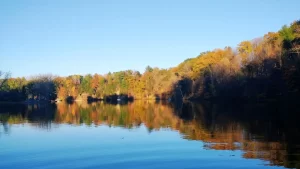Late fall fishing offers a unique opportunity to target trophy bass, but cooler temperatures and changing conditions require a strategic approach. Layer up with wool socks, grab a few hand warmers, and head out to the water with these three essential tips to boost success during the late autumn season.
1. Timing It Right While Late Fall Fishing
In late autumn, making the most of fishing hours is critical. One of the advantages of this season is that it’s often better to fish during the middle of the day when the sun is at its highest point. As temperatures peak around noon, the water warms up, which encourages bass to become more active. Starting around 11 a.m. or noon can significantly increase the chances of a productive day on the water.
Additionally, paying close attention to weather patterns is key. Even a single afternoon where air temperatures rise into the 60s can trigger a feeding frenzy, particularly when those days are surrounded by cooler temperatures in the 40s. Monitoring the weather forecast in advance allows anglers to plan around these warmer windows and maximize their chances of success.

2. Go Big or Go Home in the Fall
When it comes to bait choice, the old adage “big baits catch big fish” is especially true during the fall. As winter approaches and water temperatures drop, bass prepare for the slow metabolism that comes with hardwater conditions. Rather than expending energy on multiple small meals, bass are more inclined to pursue larger prey that offers greater nutritional value with less effort.
This is why larger profile baits, such as spinnerbaits and bulky jigs, are highly effective in the late fall. These baits imitate the bigger meals that bass seek out during this time, increasing the likelihood of attracting trophy-sized fish.
3. Slow Your Roll in Late Fall Fishing
Slowing down lure presentations is crucial during the late fall. As bass look to conserve energy, they are more likely to target large meals that are moving slowly. Slow-rolling spinnerbaits or dragging bulky jigs across the tops of green vegetation can be particularly effective. The key is to maintain slight contact with fish-holding cover, such as weeds, rocks, timber, or docks, without rushing the retrieve.
By keeping the bait in the strike zone for a longer period, anglers increase their chances of enticing a bite. This method plays into the bass’s natural tendency to prioritize energy efficiency during colder months, resulting in more successful catches.
Late fall fishing can be incredibly rewarding for those who adapt their techniques to match the changing conditions. Timing outings correctly, choosing larger baits, and slowing down lure presentations are all effective strategies for landing trophy bass as winter approaches.
Image/Source: shopkarls





